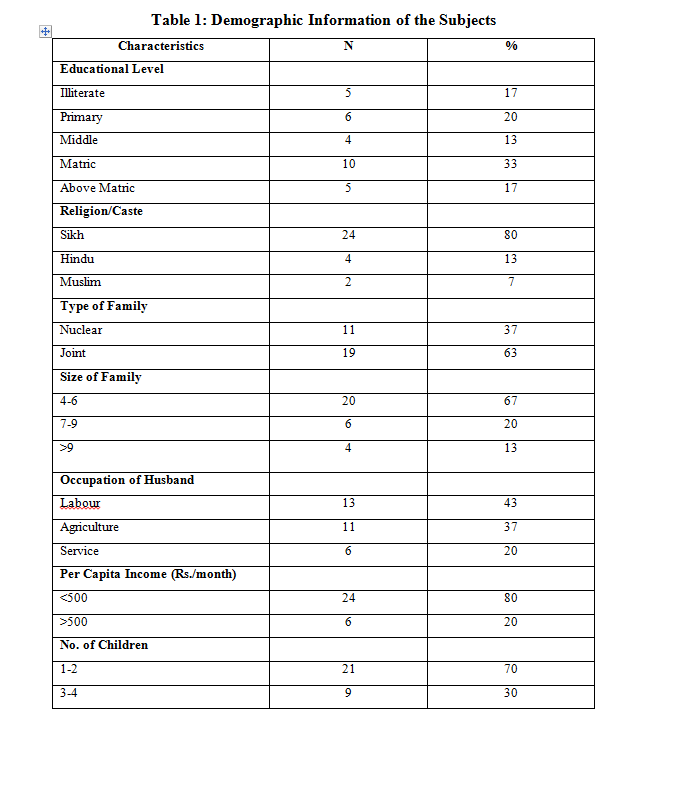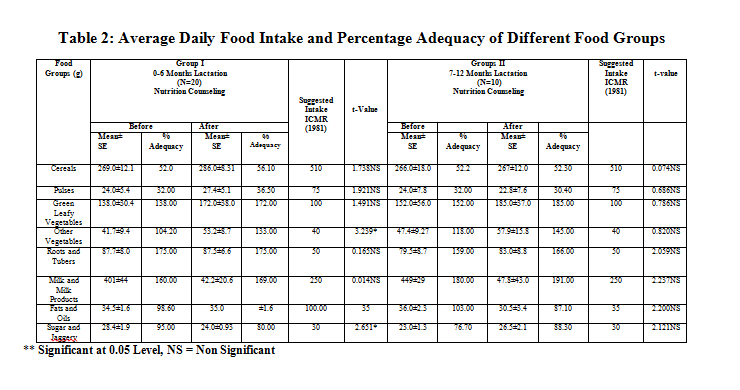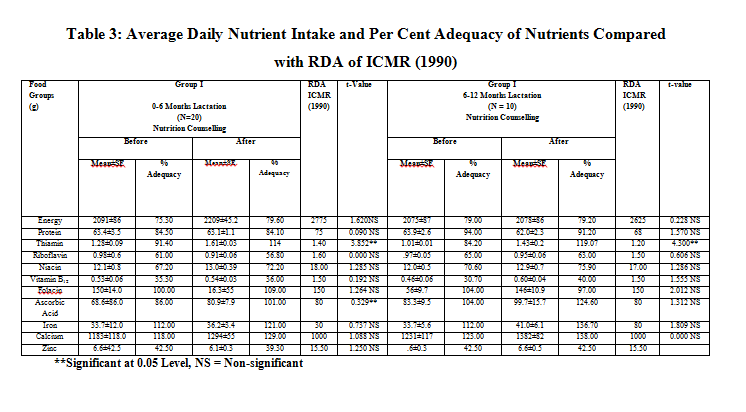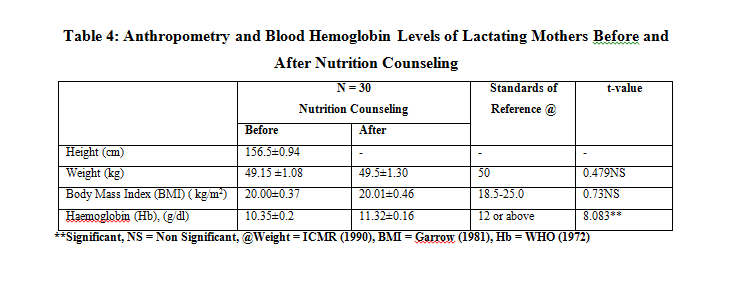Alleviation: An International Journal of Nutrition, Gender & Social Development, ISSN 2348-9340
Volume 3, Number 3 (2016) : 32-36
©Arya PG College, Panipat & Business Press India Publication, Delhi
www.aryapgcollege.com, www.apcjournals.com
Impact of Nutrition Counseling on Maternal Nutrition
Abha Khetarpal
DAV College for Girls, Yamunanagar
(Haryana), India
Email: abhakhetarpal@rediffmail.com
Introduction
Mother’s nutritional status affects the growth of the baby. The baby receives nutrients throughout the pregnancy from mother’s body. For the first 6 months after birth, the baby receives all the nutrients exclusively from mother’s milk. This is followed by gradual addition of complementary foods after 6 months along with the mother’s milk. Proper nutrition during lactation will help the baby to develop and grow normally and will also keep the mother healthy. Malnutrition is the biggest single cause of high maternal and infant mortality rate in low income group in India. The physiological developments for lactation begin during later part of pregnancy (Swaminathan 1998). The diet of women in India is not adequate in terms of quality as well as quantity. Nutritional inadequacy during lactation may aggravate chronic dietary deficiencies (UNESCO 1983). Food prejudices and false beliefs during lactation period stand in the way of adequate nutrition and thus act as obstacles in the well-being of nursing mothers and their infants. In view of this, a nutrition counseling programme was planned and its impact on the nutritional status of the nursing mothers was studied.
Material and Methods
A sample of 30 lactating mothers who visited Ravi Hospital, Yamunanagar regularly for immunization of their infants (1-12 months old) was selected.
A questionnaire was prepared to obtain general information of the subjects. Food intake was recorded by 24-Hour Recall Method for three consecutive days before as well as after imparting nutrition counseling. Nutrient intake was calculated using MSU Nutriguide Computer Program (Song et al 1992). Anthropometric measurements namely height and weight were recorded (Jelliffe 1996). Body weight was also taken after imparting nutrition education. Body Mass Index (BMI) was calculated from height and weight of the subjects (Garrow 1981).
Blood hemoglobin level before as well as after counseling was determined by cyanthaemoglobin method (Dacie and Lewis 1975). Nutrition counseling was imparted by two groups and four individual contacts over a period of three months. The nutrition counseling included importance of various groups in the daily diet, balanced diet, importance of breast feeding and colostrum, nutritional requirements during lactation, weaning foods for the infants, improving and preserving nutritive value of food by proper cooking methods and causes of anemia and its eradication through diet. Preparation of low cost and nutritious weaning foods was demonstrated in a group. Written information related to adequate nutrition was also distributed.
The whole nutrition counseling was imparted in vernacular through lectures cum demonstration. Nutrition knowledge, attitude and practices (KAP) scores of mothers was assessed before as well as after imparting nutrition counseling using a questionnaire with multiple choice questions from the above mentioned nutrition related topics. The mean, standard error and t-test were worked out to interpret the data.
Results and Discussion
The demographic information of the subjects is shown in Table 1. It can be seen that 17 per cent of the subjects were illiterate while 66 per cent were educated upto matric level. Sixty-three per cent of respondents used to live in joint families. Majority of the subjects belonged to low income families. The husbands were either laborers or had very small land holdings.

The food intake of the mothers of 0-6 (Group I) and 7-12 (Group II) months old infants is shown in Table 2. There was an inadequate intake of cereals and pulses by group I while group II had the inadequacy of sugar and jaggery along with cereals and pulses as compared to the suggested dietary intakes given by ICMR (1984). After imparting nutrition education, there was a significant (p≤0.01) increase in the consumption of other vegetables and sugar and jaggery in group I while a non-significant improvement in group II was observed after nutrition counseling.


The diets of the subjects were inadequate in terms of energy, protein thiamin, riboflavin, niacin, vitamin B12, ascorbic acid and zinc for group I, while the diets of group II were deficient in all the above mentioned nutrients except ascorbic acid against the recommended dietary allowance given by ICMR (1990). There was a significant (p≤0.01) increase in the intake of thiamin and ascorbic acid in group I and thiamin and iron in group II after the nutrition counseling (Table 3).
The subjects had only weight of 49.1±1.08 kg which was very close to the reference standards of 50 kg. The BMI was also in the normal range (18.5 to 25.0 kg/m2). A non-significant improvement in the body weight and BMI of the subjects was observed after imparting nutrition counseling while a highly significant (P≤0.01) improvement in the blood hemoglobin level was observed after counseling i.e. 10.35 to 11.32 g/dl (Table 4).
According to the BMI classification by Garrow (1981), 23 per cent of the subjects were energy-deficient (BMI ≤ 18.5) while 74 per cent were energy adequate (BMI 18.5 - 20.0). Only 3 per cent of the subjects were obese (BMI > 25.0). On the basis of WHO (1972) classification of anemia, 73 per cent of the subjects were anemic (Hb<12.0 g/dl).

The average daily intake of energy and protein was inadequate. The low consumption of cereals, pulses and sugar and jaggery could be the reason for inadequate energy and protein intake. The consumption of fats was marginally adequate whereas the intake of thiamin riboflavin and niacin in both the groups was inadequate. The intake of Vitamin B12 was grossly inadequate. Adequate amount of vitamins are essential as they are required for normal energy metabolism in the body. The adequate intake of green leafy vegetables and other vegetables resulted in higher consumption of iron and ascorbic acid. This was due to the higher availability of green vegetables and other vegetables in winter season when the study was carried out.

The mean hemoglobin level of the subjects was 10.35 g/dl which was increased to 11.32 g/dl after nutrition education. The reason could be the higher consumption of green leafy vegetables during winter season when the availability of these vegetables was abundant. The BMI of the subjects was in the normal range of 18.5 to 25.0 kg/m2. The body weight of the nursing mothers should be more than the non-nursing mothers as some fat is deposited during pregnancy which is later used for lactation.
Conclusions
The result revealed that a nutrition education programme for three months could not improve the intake of most of the nutrients except for thiamin and iron. The reason may be that the period of intervention is too short to bring desirable changes in their food intake. So, nutrition education for a longer period can prove helpful as it is difficult to change their food habits over a short period of time. However, the nutrition counseling programme improved the nutrition knowledge, attitude and practices of lactating mothers (Table 5).
References
Dacie JV and Lewis SM (1975) Practical Hematology. Great Britain: Churchill Livingstone.
Garrow JS (1981) Treat Obesity Seriously- A Clinical Manual. Great Britain: Churchill Livingstone.
ICMR (1984) Recommended Dietary Intakes for Indians. New Delhi: Indian Council of Medical Research.
ICMR (1990) Nutrient Requirements and Recommended Dietary Allowances for Indians. Hyderabad: NIN.
Jelliffe DB (1966) The Assessment of Nutritional Status of Community- World Health Organization Monographs Series-53. Geneva: WHO.
Murthy NS, Dubey S, Tiwari IC, Rao SM, Marwah VM, Gupta S and Sharma D (1975) Social Obstetrics Components of a Teaching Rural Practice Area. Ind. J. Prev. Soc. Med 6: 68-71.
Song WO, Mann SK, Sehgal SS, Devi PR, Gudaru S and Kakarala M (1992) Nutriguide-Asian Indian Foods- Nutritional Analysis Computer Programme. USA: Michigan State University.
Swaminathan M (1988) Essentials of Food and Nutrition. Madras: Ganesh and Company.
UNESCO (1983) Maternal and Young Child Nutrition- Nutrition Education Series 3. Paris: United Nations Educational, Scientific and Cultural Organization.
WHO (1972) Nutritional Anemias: World Health Organization- Tech. Rep. Ser. No. 503. Geneva: WHO.

